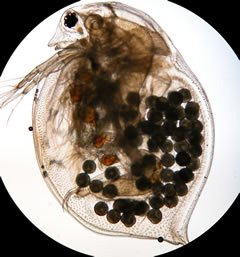Parthenogenesis is a word of Greek origin that roughly translates into “virgin creation”. You may remember learning about asexual reproduction at some point and recall that it involves an organism producing offspring without mating or exchanging genetic material with another individual. Parthenogenesis is a special type of asexual reproduction seen in organisms that produce seeds or embryos. You might be surprised to learn how widespread this type of reproduction is in the Animal Kingdom.
 In the Invertebrate world (90% of the Animal Kingdom), parthenogenesis is widespread. In many ant, bee and wasp species, unfertilized eggs will develop. Queens in these groups sometimes produce other queens through parthenogenesis. The water flea Daphnia is a crustacean species that switches between parthenogenesis and sexual reproduction depending environmental conditions. This species has been very valuable to biologists studying the evolution of reproductive behavior.
In the Invertebrate world (90% of the Animal Kingdom), parthenogenesis is widespread. In many ant, bee and wasp species, unfertilized eggs will develop. Queens in these groups sometimes produce other queens through parthenogenesis. The water flea Daphnia is a crustacean species that switches between parthenogenesis and sexual reproduction depending environmental conditions. This species has been very valuable to biologists studying the evolution of reproductive behavior.
Photo of water flea, Daphnia, with eggs from Wikicommons.
Parthenogenesis is also observed in Reptiles and has been well studied in whip-tailed lizards in the American Southwest. Individuals in this species are all female and produce eggs that develop into genetically identical females. Interestingly, whip-tails display a pseudo-mating behavior in which one female plays the role that a male would play. The behavior stimulates hormone production and increases the fertility of females of involved. More recently, parthenogenesis has been observed in Komodo dragons.
Parthenogenesis is also observed in several species of fish including sharks. There have been several cases in the news recently of female sharks living in public aquaria producing offspring with no males around. This was quite a shock to aquarium staff because it was thought sharks did not reproduce this way!
Links to shark stories:
Hammerhead shark parthenogenesis
Virgin shark birth at Virginia Aquarium (PDF file)
Parthenogenesis has not been observed in mammals and several aspects of fertilization and reproduction appear to make the process unlikely. The process can be initiated in the laboratory but is not common. Note that laboratory cloning of animals is not the same as parthenogenesis and has been accomplished on several occasions.